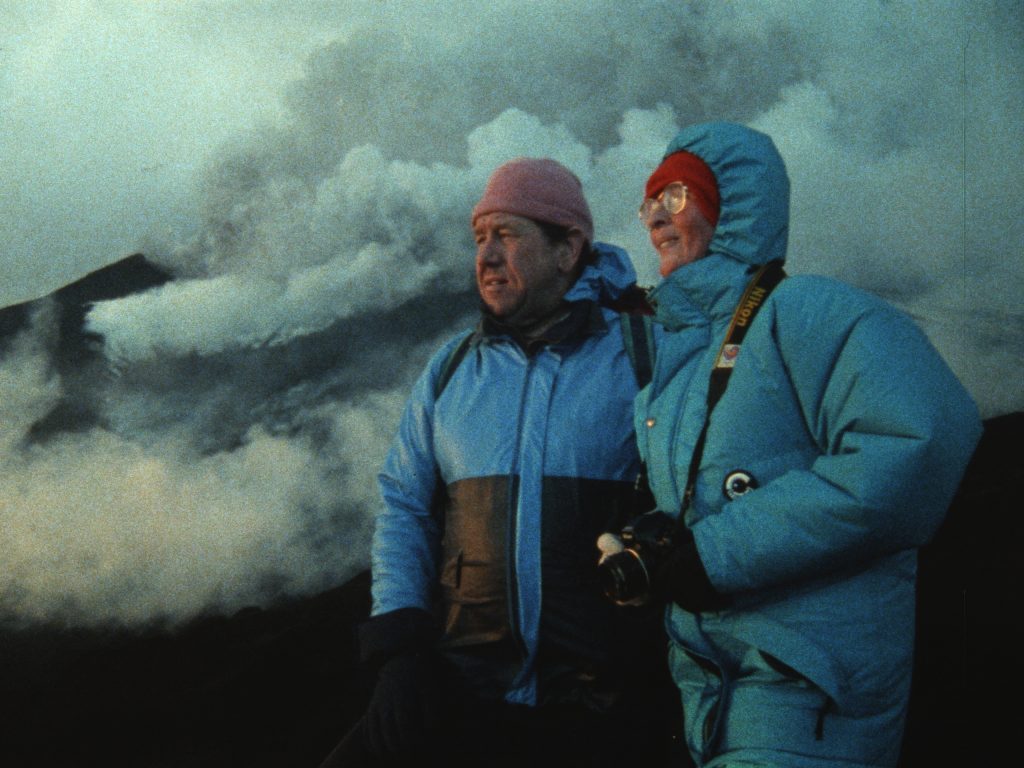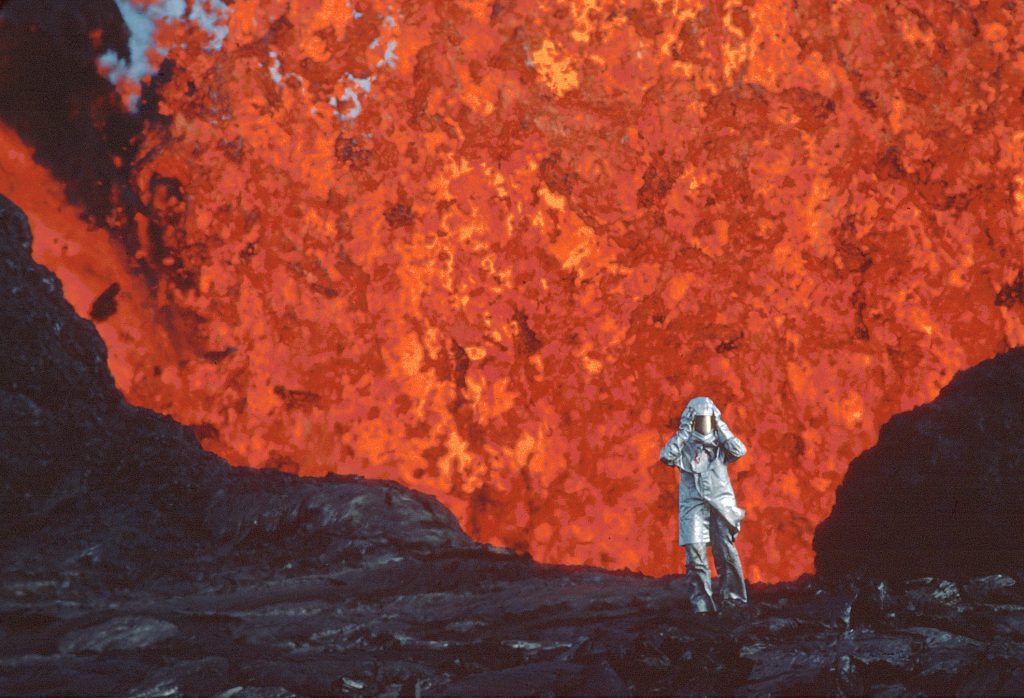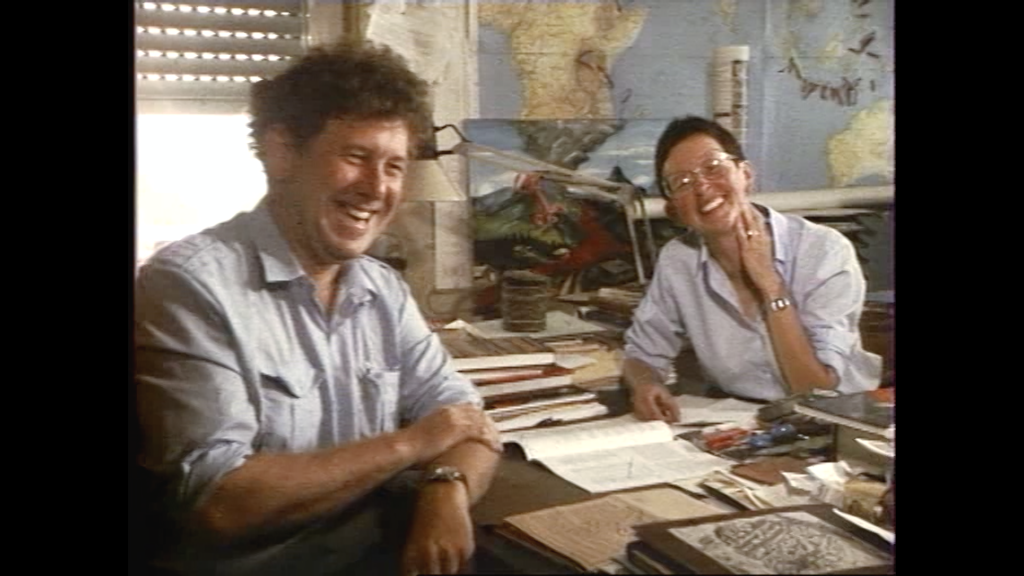In her lyrical celebration of fearless French scientists Katia and Maurice Krafft, Director Sara Dosa explores their love story and legacy through archival footage in her expressive and delicate National Geographic documentary Fire of Love. It’s some of the most spectacular footage ever recorded.
The acclaimed documentary, nominated for Best Documentary Feature at the 2023 Academy Awards, follows the daring and charismatic Volcanologist couple as they obsessively chase erupting volcanoes and document their discoveries with an unconventional approach. Their accumulated research and spectacular archival footage became their legacy after losing their lives in a 1991 volcanic explosion that resulted in 41 deaths, including scientists, firefighters, and journalists.
While working on her verite documentary The Seer and the Unseen set in Ireland, Peabody award-winning producer Dosa found the Krafft’s volcanic footage while researching erupting volcanoes. The cinematic imagery became central to Dosa’s inspiration for telling Maurice and Katia Krafft’s story, illuminating a journey of love, passion, dedication, and earnestness.
“We were fascinated by the fact that [Katia and Maurice Krafft] were geologists trying to make sense of the clues left behind on earth, to tell a story about the unknown, and what we hope to understand,” explains Dosa. “It was mirrored in the archival process in a small way because we felt their materials were like geological layers, sediments of sorts. So we had to investigate them to tell our story full of unknowns, holes, conjectures, and hypotheses.”
The film premiered on Opening Night at Sundance 2022 and won the Critic’s Choice award for Best Archival Documentary. Instead of emphasizing the tragedy of their deaths, Dosa and her editors, including Erin Casper and Jocelyne Chaput, showcase the Krafft’s obsession with the planet’s mysteries by utilizing their treasure chest of astonishing imagery alongside their whimsical approach to death-defying research.
Fire of Love is, first and foremost, a love story centered around a couple often described as “traveling performer volcanologists” and weaves a celebratory portrait of a love triangle with a softly spoken narration from Miranda July.
“There’s a sentence in a book that Maurice wrote where he said that for him and Katia and the volcanoes, it is a love story,” shares Dosa. “It was really a genesis point and understanding how to see and approach their material and recognize that this love story was key.”
Following her win at the Director’s Guild Awards for Outstanding Directorial Achievement in a Documentary, Dosa spoke with Awards Focus about blazing through the awards season, balancing the Krafft’s eccentricities with their critical research, and shares the melancholy backstory created for Miranda July’s narrator that inspired the script.

Awards Focus: Congratulations on the DGA win this past weekend. How did it feel to be recognized at these awards?
Sara Dosa: It was an extraordinary honor to be recognized by the DGA in that way. I felt so surprised, and those filmmakers [in the category] have become friends of mine. I could physically feel my heart expand.
I always dreamed of being a director, but it felt very out of reach. So I climbed my way up, like I was PA’ing, then was a production coordinator and gradually worked as a producer. I was learning filmmaking from some amazing mentors but dreaming of my own projects as a director and working on them on nights and weekends until I could finally scrape together enough grant money to work on my stuff.
Fire of Love was my first opportunity. Finally, I received funding and felt like I had my dream job. To get recognized for that meant so much.
AF: During the awards season, you’re swimming in a pool with a collection of nominated filmmakers for a few months. Was there someone that gave you praise or a piece of advice that stuck with you?
Dosa: A lot of the advice I’ve been getting is about savoring the moment because this is so intense. I had a conversation the other day with Alfonso CUARON the other day. Y Tu Mama Tambien was one of those films that ignited my imagination and helped me fall in love with cinema. That film was one that we studied time and time again while making Fire of Love because our film is a love triangle between two humans and volcanoes. The narration in that film is also stunning, so we were trying to absorb it.
AF: How familiar were you with the work of Maurice and Katia Krafft before the project?
Dosa: I wasn’t familiar with them at all. I came across the story of the Kraffts while researching the last film I directed. It was a Verite documentary that we shot in Iceland, which is a volcanic island. We wanted archival imagery of erupting volcanoes to open that film. Once we started researching to get that imagery, we found Katie and Maurice because not that many people had shot archival footage of erupting volcanoes in Iceland.
The imagery was so spectacular, and they so inspired us. Once we discovered this beautiful love story there, we thought this would be a fantastic project to work on. We were about to start a new project about these mysterious methane explosions in Siberia, but the pandemic hit, and that project unfortunately collapsed.
That’s when we pivoted to realize working on an archival film during the pandemic could be a wonderful way to continue to do work, and that’s when everything got rolling.

AF: Why did you primarily use the archival footage rather than intersperse interviews and incorporate people who knew the Kraffts?
Dosa: There are a lot of reasons why we chose not to. I should say there are about eight shots in the film originally shot by a wonderful cinematographer Pablo Alvarez-Mesa. Aside from that, it’s all archival, along with our animation, which we wanted to keep as close to the Kraffts as possible.
The kinship between geologic methodology and the archival filmmaking process interested us. We wanted to bring that into our filmmaking and subtly acknowledge that process. We also wanted to place the audience in the tension of the present moment in a film that’s principally about time, life, and death. So having the audience drop into the moment with Katia and Maurice was all the more important.
We thought if we had talking heads or experts who were speaking from the future or now, it would break that temporality essential to conjuring the tension. It would also break the intimacy of the love triangle that we really wanted to preserve around Katia, Maurice, and the volcanoes.
That said, such important information came out in the interviews we conducted with collaborators, family members, and cinematographers they worked with. That filtered into the narration for added context and insight.
AF: There’s a delicate balance in the film where you’re showcasing the love triangle between Maurice, Katia, and the volcanoes with the informative subject of volcanoes, and the whimsical and playful spirit of their research footage. What conversations went into structuring this documentary to support that balance?
Dosa: That’s a great question. It was a challenge for us because there were many different themes, locations, and characters. Finding the right balance was quite arduous, but I had amazing editors Erin Casper and Jocelyne Chaput, along with Shane Boris and Ina Fichman. I could go on and on about my wonderful team, but for us, we tried to look at thematic resonance in capturing Maurice’s work. We tried to crystallize the story and narrative around this idea of love, understanding, and science and understanding.
There’s a line in the film that comes in like 18 minutes in where our narrator Miranda July says, “Understanding is love’s other name.” It’s a line inspired by the work of a Zen Buddhist monk Thich Nat Hanh and captures the film’s heart in that scientific inquiry is about this deep exploration. Katia and Maurice felt like they understood the secrets of the planet. They were going into the mystery and the unknown, which was so exhilarating for them. That brought them a more profound sense of empathy and love for the planet and the fact that they got to do it together while learning so much about their relationship at the same time.
That pathway into the known for the pursuit of knowledge brought them love and meaning. Of course, some people might say a science story is very different than a love story, which is different than a character portrait, but they all connect and orbit around each other.
AF: It feels like those two stories, between science and love, were mirrored in the variances between red volcanoes and gray volcanoes.
Dosa: That was also a useful narrative device for us that felt true to their work. They started out being so drawn to red volcanoes, which they thought of as creative forces. Then, of course, the more they learned about them, the more they realized that they too were quite destructive. But in this pursuit of knowledge, as well as the thrill of getting close to danger and being animated by that danger, it brought them closer. The balance between creation and destruction and creation again mirrored their life’s path, their actual chronology, and structurally, for us, it was fascinating and valuable.

AF: Miranda July’s dead-pan narration countered that presence of danger so well in the film. How did you conceive of the script and take quotes like the one from Ticht Nat Hanh and infuse it into the narration without seeming too sentimental?
Dosa: The narration was the most challenging part of this already very challenging film.
Initially, we didn’t want narration for Fire of Love. We wanted the archives to speak for themselves. However, telling this love triangle story was perhaps the truest interpretation of their legacy, and you could interpret it in many ways. I really think you could make a hundred films out of their footage. They’re so mythic, you know?
At first, our narration was very expository but it was helpful for us as we were figuring out the structure of the film. We were also guided by the French New Wave, which Maurice and Katie were very influenced by growing up in the sixties and seventies in France. You could see the inflection of that movement in their work. For example, Maurice had fun snap zooms in his work, which people now associate with Wes Anderson.
It was also really important for us to have a woman’s voice to recenter on a woman’s perspective. There’s a crazy high statistic of male voices narrating nature films, so we wanted to reclaim it. We also wanted the voice to be curious and inquisitive, just like Katia’s and Maurice’s own nature. The narrator didn’t need to have all the answers or claim to know everything because Katia and Maurice were in the process of discovery themselves. So together with my two editors, Erin and Jocelyn, and Shane Boris, the four of us collaboratively wrote the narration.
We actually wrote a backstory for the narrator to ground ourselves. We didn’t want the audience to know what it was, but it was very cool for us.
AF: What was the back story you gave to the narrator, and how detailed were you in that approach?
Dosa: [Laughs] It’s very detailed.
The broad strokes are that it was an American woman who was approaching the age of Katia and Maurice when they died and who had recently had her heart broken. She grew up with a mother who was a park ranger working in Yellowstone, so she grew up around these geothermal landscapes, and volcanism makes her think of home.
In her recent heartbreak, she moves to France. She’s also kind of romantic and was obsessed with the French New Wave. She’s going through this radical break-up in life and is going to the place she always dreamed of, but she can’t get work except for archival cataloging in the basement of an old science archival house. This is a lot of detail [laughs].
AF: It’s fantastic! I love this expansion of her life. Is this how she came to the Krafft’s tapes?
Dosa: Well, she’s tasked with organizing dental records from the seventies, which makes her go crazy. No one’s ever going to see these, so it feels absurdist or like an existentialist comedy of no one is going to see these records of teeth. However, she still has to organize them impeccably, and the teeth make her think about her own mortality.
One day, she stumbles upon this trove of images from the Kraffts, and it soothes her soul. She’s so curious to learn everything about these people and starts to think of the Kraffts as these friends she’s discovered.
There are also other details like she has a pet tortoise who will outlive her, which brings her stress because if she doesn’t find love again, who will take care of the tortoise?
AF: I love it. There could be a narrative feature from the perspective of the tortoise. The character portrait also sheds a lot of light on Miranda July’s tone in her narration.
Dosa: We used as much of Katia’s and Maurice’s interviews as possible in the narration. We wanted it to give just enough to put attention of certain places or elicit questions and were mindful of the balance.
AF: In Grizzly Man, Werner Herzog deliberately leaves out footage from the archives of his subject that would be deemed too illicit or confronting for viewers and disrespectful to loved ones. Did you encounter footage with Maurice and Katie that you thought should not be included in the film?
Dosa: We didn’t come across that footage, but if we had, we would not have included it for the same reason. 41 people died with Katia and Maurice that day in June 1991. The people are still mourning the loss of their lives, and it was really important to us to be respectful and sensitive to that. We did not want to sensationalize their death at all. That’s part of the reason why we say that they died early in the film, at around the six-minute mark.
One of the other reasons was we didn’t want their death to be treated as some sort of third-act reveal. There’s something about our film where we feel like Katia’s, and Maurice’s death is not actually the end. It’s them joining the earth and joining in kind of the great cycles of creation and destruction that volcanoes represent. So aside from the sensitivity issues, even if that footage existed, it would take away from this greater meaning.
It would make it so literal, their death would be literal, but visually we wanted to pay homage to this grand love of them joining the earth rather than being seen in these physical bodies.



